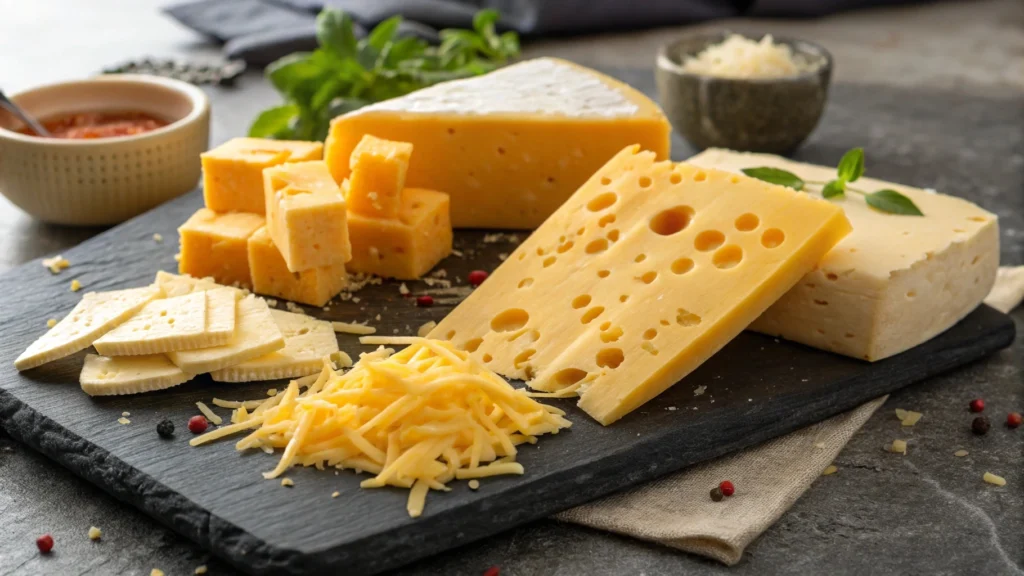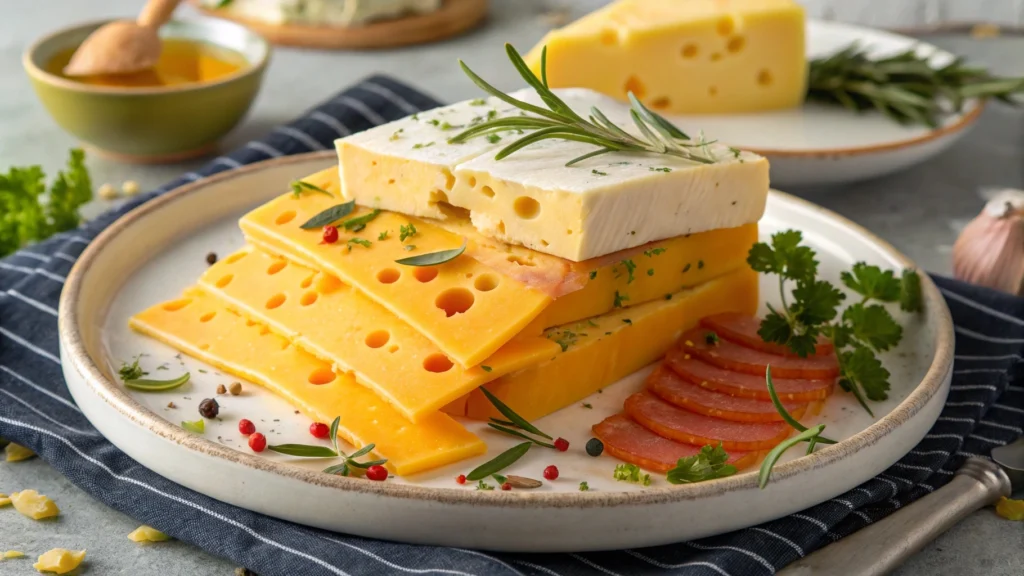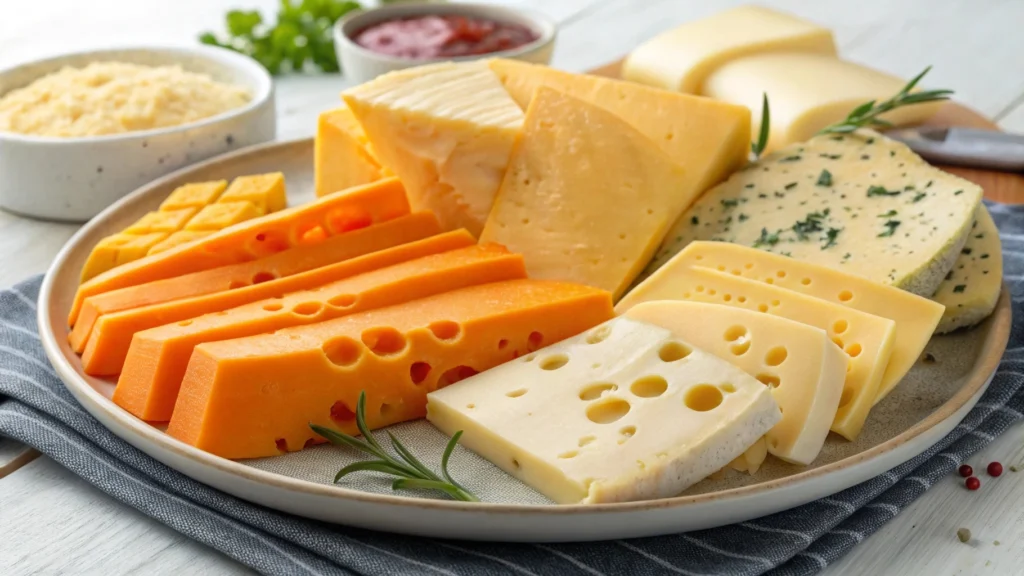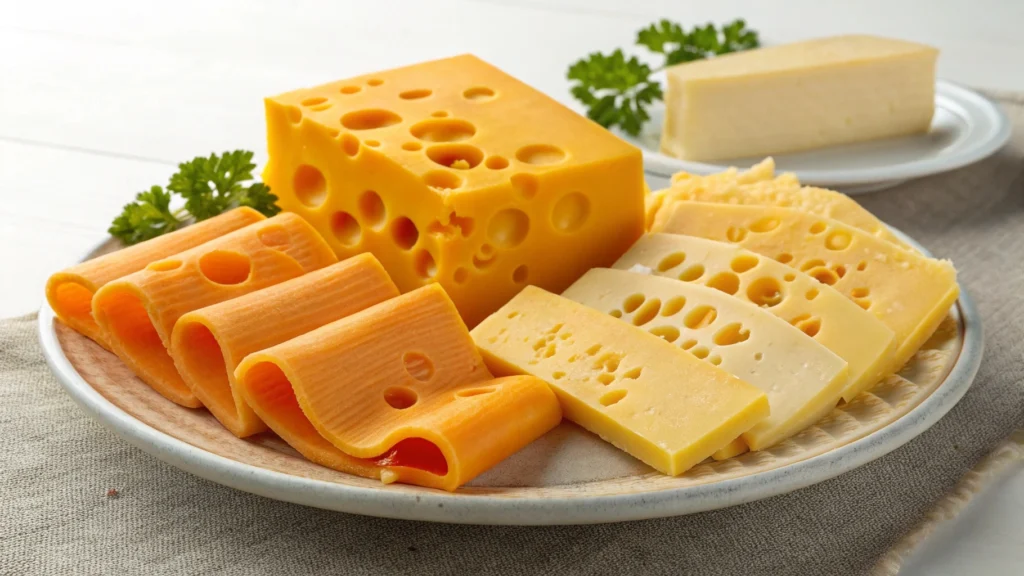Introduction: The Allure of Cheese – More Than Just a Dairy Delight

Cheese. It’s one of those foods that can instantly elevate any meal, from a simple sandwich to an elaborate charcuterie board. Whether it’s the creamy richness of brie or the sharp tang of cheddar, cheese is a versatile ingredient that has been cherished for centuries. But with so many varieties available—Cheddar, American, Swiss, and beyond—how do you know which one to choose?
If you’ve ever found yourself standing in front of a cheese section in the grocery store, feeling overwhelmed by all the options, you’re not alone. Understanding the different types of cheese and how they can complement your dishes is essential to making the right choice. In this guide, we’ll break down everything you need to know before you buy cheese, ensuring you select the perfect variety for your taste and culinary needs.
Types of Cheese: A Guide to Popular Varieties
Cheese comes in many forms, flavors, and textures. Each type has its own unique characteristics, making it suitable for different culinary uses. In this section, we’ll explore the most popular varieties: Cheddar, American, Swiss, and a few others.
Cheddar Cheese: A Sharp, Savory Classic
- Description & Flavor Profile: Cheddar is one of the most beloved cheeses worldwide. Known for its firm texture and distinct sharp taste, cheddar can range from mild to extra sharp depending on the aging process.
- Common Uses: Ideal for sandwiches, burgers, and grilled cheese. Its melting quality also makes it perfect for sauces and casseroles.
- Varieties to Explore: Mild cheddar, sharp cheddar, and extra sharp cheddar.
American Cheese: The Melt-Perfect Cheese
- Overview & Characteristics: American cheese is smooth, creamy, and has a mild flavor that makes it a favorite in the U.S. Its bright yellow color and uniform texture come from a combination of cheddar and other dairy ingredients.
- How It Differs: Unlike cheddar, American cheese has a more consistent texture and is designed specifically for melting, making it the perfect choice for burgers and grilled cheese sandwiches.
Swiss Cheese: A Mild and Nutty Option
- Key Features: Swiss cheese is easily recognizable by its characteristic holes and smooth texture. Its flavor is mild, slightly nutty, and sweet, making it perfect for both savory and sweet dishes.
- Common Uses: Swiss cheese pairs wonderfully with deli meats in sandwiches or can be melted on top of French onion soup.
Other Popular Cheeses to Consider
- Mozzarella: Mild and stretchy, perfect for pizza or caprese salads.
- Brie: Soft, creamy, and buttery—ideal for cheese boards or as a topping for baked goods.
- Gouda: Smoky and slightly sweet, often used in both cooking and on cheese boards.
- Blue Cheese: Bold, tangy, and pungent—perfect for salads and dressings.

How to Choose the Best Cheese for Your Needs
With so many types of cheese, how do you select the right one for your specific needs? Here’s a breakdown of factors to consider when shopping for cheese.
Best Cheeses for Cooking
- Melting Cheeses: When making a cheesy sauce, pizza, or a grilled sandwich, look for cheeses like cheddar, mozzarella, or fontina for their excellent melting qualities.
- Cheese for Grilling: Use cheeses like provolone or gouda, which hold their shape well under heat and add a rich flavor to grilled dishes.
Cheeses for Snacking
- Charcuterie Board Staples: For a well-rounded cheese board, opt for a mix of textures and flavors—cheddar, brie, and blue cheese make great choices.
- Portable Snacks: Grab-and-go cheeses like string cheese or babybel are perfect for quick snacks.
Special Diet Cheese Options
- Lactose-Free Cheese: If you’re lactose intolerant, look for cheese labeled as “lactose-free” or choose harder cheeses like cheddar or parmesan, which tend to have less lactose.
- Vegan Cheese: For those following a plant-based diet, vegan cheeses made from cashews, soy, or coconut provide a dairy-free alternative.
- Organic Cheese: If you prefer organic products, many brands offer cheeses made from milk produced by cows that are raised without synthetic hormones or antibiotics.
Cheese Pairings: Elevate Your Meal
- Wine Pairings: Pair rich cheeses like brie and gouda with full-bodied wines like Cabernet Sauvignon or Merlot. For sharp cheeses like cheddar, a crisp Chardonnay works well.
- Fruit Pairings: Soft cheeses like goat cheese go well with figs and pears, while cheddar pairs nicely with apples and grapes.
Understanding Cheese Texture and Flavor Profiles
The texture and flavor of cheese can vary widely. Understanding these differences is key to selecting the right cheese for your meal.
Soft vs. Hard Cheese
- Soft Cheese: Brie, camembert, and goat cheese are examples of soft cheeses that have creamy textures and spreadable consistency.
- Hard Cheese: Parmesan, aged cheddar, and asiago are firm, dense, and often crumblier in texture. These cheeses are perfect for grating over pasta or salads.
Mild vs. Sharp Flavors
- Mild Cheese: Cream cheese, mozzarella, and havarti offer subtle flavors that complement more delicate dishes.
- Sharp Cheese: Aged cheddar, blue cheese, and gorgonzola have bold, tangy flavors that stand out in dishes.
Aged Cheeses
- The Aging Process: As cheese ages, its flavor intensifies, and its texture becomes firmer. Aged cheeses like sharp cheddar and parmesan have a deeper, more pronounced taste.
- Best Uses for Aged Cheese: Aged cheeses are ideal for adding a punch of flavor to pasta dishes, risottos, and salads.
Unique Cheese Varieties
- Blue Cheese: Known for its distinctive blue veins, blue cheese has a strong, pungent flavor that pairs well with fruits like pears and nuts.
- Feta: Crumbly and tangy, feta is often used in Mediterranean salads or as a topping for roasted vegetables.
- Goat Cheese: Soft, creamy, and slightly tart, goat cheese adds flavor and texture to salads and pasta dishes.

How to Store and Preserve Cheese for Freshness
Proper cheese storage ensures your cheese stays fresh for as long as possible. Follow these tips for optimal cheese preservation.
Storage Tips
- Wrap Cheese Properly: Use wax paper or parchment paper to wrap cheese, then store it in an airtight container to preserve flavor and prevent drying.
- Refrigeration: Most cheeses should be stored in the fridge, except for cheeses like brie and camembert, which can be kept at room temperature for short periods.
Cheese Shelf Life
- Fresh vs. Aged Cheese: Fresh cheeses like ricotta and cream cheese have a shorter shelf life, while aged cheeses can last for several weeks or even months when properly stored.
- Signs of Spoilage: Look for mold, sour smells, or changes in texture as indicators that cheese has gone bad.
Can You Freeze Cheese?
- Freezing Cheese: Freezing cheese is possible, but it can change its texture. Hard cheeses like cheddar freeze well, while soft cheeses may become crumbly after thawing.
Proper Cheese Handling
- Preventing Mold: Mold is common on cheese but can be trimmed away. Be sure to handle cheese with clean hands or utensils to prevent contamination.
Common Mistakes When Buying Cheese and How to Avoid Them: Cheese Cheddar American Swiss
Choosing the wrong cheese can ruin a dish. Here are some common mistakes to avoid when buying cheese.
Processed vs. Natural Cheese
- Understanding Processed Cheese: Processed cheeses like American cheese slices are made with additives and emulsifiers, whereas natural cheeses are crafted from milk, rennet, and cultures.
- Why It Matters: Natural cheeses tend to have richer flavors and are healthier because they don’t contain artificial ingredients.
Not Considering Cheese Texture
- Texture Affects Flavor: If you’re making a creamy pasta, a soft cheese like ricotta may be your best bet. For grating, opt for harder cheeses like parmesan.
Overbuying or Underbuying
- Buying Too Much Cheese: Cheese can be expensive, and if you buy more than you need, it may spoil before you use it. Stick to the amount required for your recipes.
Ignoring Cheese Aging
- Aging Matters: Cheeses that are too young or over-aged may not offer the flavor profile you’re seeking. Know when to choose a fresh or aged variety.

Conclusion: Cheese Cheddar American Swiss
Cheese is more than just a tasty treat; it’s an essential ingredient in countless dishes, offering versatility, flavor, and texture. By understanding the different types of cheese, how to select them, and how to store them, you can take your culinary adventures to the next level.
So, the next time you find yourself in the cheese aisle, take a moment to think about what you’re looking for—whether it’s the creamy tang of cheddar, the smooth meltability of American cheese, or the nutty depth of Swiss. Your perfect cheese is waiting to elevate your meals.
FAQ: Cheese Cheddar American Swiss – Your Essential Guide
What is the best cheese for melting?
Cheddar, mozzarella, and gouda are some of the best cheeses for melting.
How do I store cheese properly?
Wrap cheese in wax paper or parchment paper, then place it in an airtight container in the fridge.
What’s the difference between cheddar and American cheese?
Cheddar has a sharper taste and a firmer texture, while American cheese is creamier and designed for melting.
Can I freeze cheese?
Yes, you can freeze cheese, but it may change its texture, especially for softer cheeses.
Which cheeses are good for cheese boards?
Cheddar, brie, gouda, and blue cheese make excellent cheese board options.
